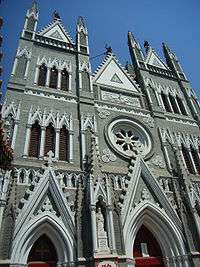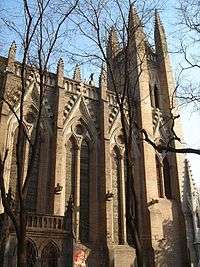Church of the Saviour, Beijing
| Church of the Saviour, Beijing | |||||||||
|
The west facade | |||||||||
| Traditional Chinese | 救世主堂 | ||||||||
|---|---|---|---|---|---|---|---|---|---|
| Simplified Chinese | 救世主堂 | ||||||||
| |||||||||
| Alternative Chinese name | |||||||||
| Chinese | 北堂 | ||||||||
| Literal meaning | The North Cathedral | ||||||||
| |||||||||

The Church of the Saviour (Chinese: 救世主堂), colloquially referred to as Xishiku Church (Chinese: 西什库天主堂) or Beitang (Chinese: 北堂; literally: "the North Church") is a historic Catholic church in the Xicheng District, Beijing, China. Of all the cathedrals and churches located in Beijing, the Xishiku church is one of the most ornate and magnificent.
The church was originally established by the Jesuits in 1703 near Zhongnanhai (opposite the former Beijing Library), on land bestowed by the Kangxi Emperor of the Qing dynasty to the Jesuits in 1694, following his recovery from illness thanks to medical expertise of Fathers Jean-François Gerbillon and Joachim Bouvet.[1] The emperor also hand-wrote the calligraphy plaque and couplets for the building. It was named "Saviour Church" and officially opened on 9 February 1703.[2]
In 1887 the church was moved and rebuilt at its current location, at the request of the Guangxu Emperor, who needed the original space near the Forbidden City to create the Zhongnanhai Park. The cathedral's present cast iron Gothic architectural style and elaborate grey marble facade was built in 1890, under the direction of Lazarist missionary Bishop Pierre-Marie-Alphonse Favier (1837-1905), who designed it. The church stands in a spacious grounds surrounded by pine and oak tree and two Chinese pavilions.[3]
The church is also where the Beijing Bishop Office is located and it is affiliated with the Patriotic Catholic Church of China.
The siege of Beitang (14 June-16 August 1900)

During the Boxer Uprising, the Roman Catholic Church's Beijing Northern Church (known as the Peitang, and later Beitang) was under siege by an estimated ten thousand Boxers from 14 June 1900 until 16 August 1900.[4] Its defence was led by Pierre-Marie-Alphonse Favier (1837-1905), the Vicar Apostolic of the Roman Catholic Church's North Chihli Province, and architect of the cathedral. According to W.A.P. Martin, "the defence of that cathedral forms the most brilliant page in the history of the siege."[5] Favier's "successful defense of Peking's Peitang Cathedral was nothing short of a Christian miracle."[6] According to Martin, "The new, or northern, church, standing in an open ground by itself, was considered capable of defence. Monsignor Favier bravely resolved to hold it at all hazards, and thus preserve the lives of three thousand converts who had there taken refuge."[5] As the cathedral was located inside the Imperial City, Beijing near the western Gate, about three kilometres (2 miles) from the Legation Quarter, it was isolated from the foreign Legations.[7] Martin explains:
Not until the siege was raised, however, had we any conception of the severity of the conflict that devoted band had to wage in order to keep the enemy at bay; for from us, though separated only by an interval of two miles in a direct line, they were cut off from communication as completely as if they had been situated at the north pole.[5]
The Eastern and Southern churches were heavily damaged, as were all other Roman Catholic properties in Beijing. Favier estimated that during the Boxer Uprising that between 15,000 and 20,000 members of his flock were killed and that three-quarters of the chapels were destroyed.[8] During the siege, more than 3,900 people (including about one hundred Europeans, primarily women and children, and 850 orphans) sought sanctuary within the stone walls of the church,[7] which was defended by only forty-one French and Italian marines, led by two French officers. Believing the church would be attacked by the Boxers, from mid-May Favier was able to collect huge stores of food, weapons and ammunition, but the large numbers of refugees necessitated severe rationing until the siege was lifted on 16 August 1900 by the Japanese military.[9][10] During his trip to China in the summer of 1901, missionary statesman Arthur Judson Brown (1856-1963) interviewed Favier, who gave detailed description of the damage inflicted during the siege:
I called on the famous Bishop. He was, for he has since died, a burly, heavily-bearded Frenchman of about sixty-five apparently. He received us most cordially and readily talked of the siege. He said that of the eighty Europeans and 3,400 Christians with him in the siege, 2,700 were women and children. Four hundred were buried, of whom forty were killed by bullets, twenty-five by one explosion, eighty-one by another and one by another. Of the rest, some died of disease but the greater part of starvation. Twenty-one children were buried at one time in one grave. Beside these 400 who were killed or who died, many more were blown to pieces in explosions so that nothing could be found to bury. Fifty-one children disappeared in this way and not a fragment remained.[11]
Location
The church can be reached from exit D of Xisi Station on Line 4 of the Beijing subway. It is situated on Xishiku Street.
See also
- Jesuit China missions
- Roman Catholic Archdiocese of Beijing
- Cathedral of the Immaculate Conception, Beijing (Nantang)
- Church of St Joseph, Beijing (Dongtang)
- Church of Our Lady of Mount Carmel, Beijing (Xitang)
- St. Michael's Church, Beijing (Donjiaomingtang)
Notes
- ↑ Shenwen Li, p.235
- ↑ Xishiku Catholic Church
- ↑ Xishiku Cathedral, Beijing, China
- ↑ M.A. Aldrich, The Search for a Vanishing Beijing, (Hong Kong University Press):143.
- 1 2 3 W.A.P. Martin, "A Western Account of the Boxer Rebellion at Peking," from The Siege in Peking, China against the World (New York, F. H. Revell Company, 1900); http://www.shsu.edu/~his_ncp/bxr2.html (accessed 12 January 2009).
- ↑ http://www.walkerbooks.com/books/catalog.php?key=76 (accessed 11 January 2009).
- 1 2 "Beijing (Peking) Legations, China, Siege (1900)", 48-52, in The War of 1898 and U.S. Interventions, 1898-1934: An Encyclopedia, ed. Benjamin R. Beede. Taylor & Francis, 1994.
- ↑ Annals of the Propagation of the Faith LXIV: 18,19.
- ↑ Elleman, Modern Chinese Warfare, 126-128.
- ↑ Ruoff, 48.
- ↑ Arthur Judson Brown, New Forces in Old China: An Inevitable Awakening, 2nd ed. 1904, 199.; (accessed 11 January 2009).
References
- Li, Shenwen, 2001, Stratégies missionnaires des jésuites français en Nouvelle-France et en Chine au XVIIIe siècle, Les Presses de l'Université Laval, L'Harmattan, ISBN 2-7475-1123-5
External links
| Wikimedia Commons has media related to Xishiku Cathedral. |
Coordinates: 39°55′26″N 116°22′21″E / 39.92389°N 116.37250°E

